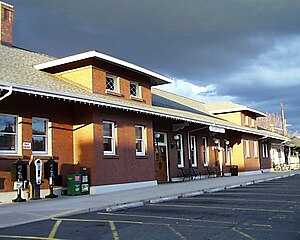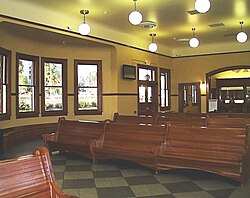Eugene–Springfield station
|
Eugene–Springfield
|
||||||||||||||||
|---|---|---|---|---|---|---|---|---|---|---|---|---|---|---|---|---|
 |
||||||||||||||||
| Location | 433 Willamette Street Eugene, Oregon United States |
|||||||||||||||
| Coordinates | 44°03′19″N 123°05′32″W / 44.05528°N 123.09222°WCoordinates: 44°03′19″N 123°05′32″W / 44.05528°N 123.09222°W | |||||||||||||||
| Owned by | City of Eugene | |||||||||||||||
| Line(s) | Union Pacific Railroad | |||||||||||||||
| Platforms | 1 side platform | |||||||||||||||
| Tracks | 2 | |||||||||||||||
| Construction | ||||||||||||||||
| Disabled access | Yes | |||||||||||||||
| Other information | ||||||||||||||||
| Station code | EUG | |||||||||||||||
| History | ||||||||||||||||
| Opened | 1908 | |||||||||||||||
| Rebuilt | 2004 | |||||||||||||||
| Traffic | ||||||||||||||||
| Passengers (2016) | 93,182 |
|||||||||||||||
| Services | ||||||||||||||||
|
||||||||||||||||
|
Southern Pacific Passenger Depot
|
||||||||||||||||

Interior of the Eugene Depot
|
||||||||||||||||
| Location | Eugene, Oregon | |||||||||||||||
| Architect | Modeled after stations by H. H. Richardson | |||||||||||||||
| Architectural style | American Craftsman, Richardsonian Romanesque | |||||||||||||||
| NRHP Reference # | 07000823 | |||||||||||||||
| Added to NRHP | August 16, 2007 | |||||||||||||||
Eugene–Springfield is a historic train station in Eugene, Oregon, United States. It is served by Amtrak's Coast Starlight passenger train and is the southern terminus of the Amtrak Cascades. The station is also served by the Cascades POINT bus service.
The station was built in 1908 by the Southern Pacific Railroad and was listed on the National Register of Historic Places as the Southern Pacific Passenger Depot in 2007.
The current station is the third passenger depot built at this location. Built of masonry, it is one of five masonry depots that still exist along the original Southern Pacific West Coast line. The other depots are in Albany, Medford, Roseburg and Salem.
Southern Pacific sold the building to the Jenova Land Company in 1993, and ten years later the city of Eugene bought the depot as part of a plan to develop a regional transportation center. In 2004, the city oversaw a $4.5 million restoration project. Workers restored the exterior brickwork and trim and gutted and renovated the interior. New tile floors, oak and fir trim, covered ceilings, wooden benches and expanded bathrooms were installed.
...
Wikipedia
